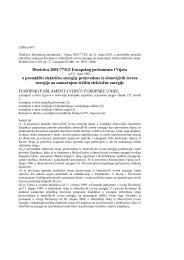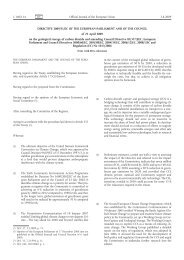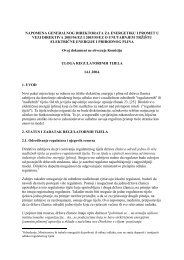ili naroËito u sluËajevima kada su dræavna tijela teprofite oduzela energetskim subjektima. S drugestrane, niski ili nedovoljno visoki iznosi naknadaza koriπtenje mreæa direktno ugroæavaju poslovanjeenergetskih subjekata, kvalitetu usluga i funkcijakoje ti subjekti pruæaju, a ako takvo stanje trajeduæe, onda i tehniËko-tehnoloπke osobine samemreæe i sustava.KonaËan zakljuËak u pogledu prethodnog bioje da bez obzira na uzroke, svaki problem i svakaposljedica prenosi se na korisnika ili krajnjegkupca i postaju njegov problem, a obvezaje i energetskog subjekta i regulatornog tijelada u reguliranom okruæju te probleme i posljediceotklone. Najefikasnijim opÊim pristupomotklanjanja svih negativnih posljedica ocjenjujese pragmatiËni pristup i postupanje, a ako jemoguÊe i suradnja sve tri zainteresirane strane.9) Poseban problem i izazov predstavlja regulacijamreænih infrastrukturnih monopola, prijenosa i distribucije,te u svezi s tim usko povezani problemgdje i pod kojim uvjetima se osiguravaju pomoÊneusluge sustava. NaroËito se u segmentu pomoÊnihusluga sustava mogu pojaviti dominantne pozicijei zlouporabe u joπ uvijek znaËajno integriranim sustavima,kada se poduzeÊima iz sustava ili grupeosiguravaju povoljniji uvjeti pristupa i koriπtenjapomoÊnih usluga ili njihova plaÊanja. U sprjeËavanjutakvih situacija, πtoviπe njihova sankcioniranja,presudna je uloga regulatornih tijela.Problem pomoÊnih usluga i odgovornosti za njihovoosiguranje i pruæanje usko je vezan s postojeÊimzakonodavnim i regulatornim okvirom, ili opÊenitopitanjem da li se na taj segment primjenjuje reguliraniili træiπni kontekst. U svakom sluËaju, u svezis tim segmentom najviπe je pitanja i dilema. Pitanjeje i kojoj djelatnosti iz dosadaπnje integriranestrukture i jedinstvene tarife koja je ukljuËivalasve djelatnosti i usluge pridijeliti odgovornost zaosiguranje pomoÊnih usluga, i kako te usluge naplatiti,kao dio odgovarajuÊih naknada ili zasebno.Neke zemlje taj problem razrijeπile su pridjeljujuÊiobveze i funkcije osiguranja pomoÊnih uslugaoperatorima prijenosnih i distribucijskih sustava,odnosno uvodeÊi ugovorne odnose po kojimatræiπni sudionici i te usluge slobodno ugovaraju,osiguravaju i na kraju plaÊaju. No, istaknuto je,da su takva rjeπenja i mehanizmi bili moguÊe teknakon πto je uspostavljena cjelovita funkcionalnai provedbena shema osiguravanja, tj. izvora i pridjeljivanjasvake pojedinaËne pomoÊne usluge ilinjene komponente, ali i uvjeta njihova eventualnogprekida i posljedica toga prekida. »injenicaje da su u nekim zemljama, a radi se o zemljamai energetskim gospodarstvima koja su u pravilu uranim fazama procesa restrukturiranja, otvaranjato very high or inadmissibly low charges for networkuse. High charges for network use would not onlymean high costs for network users but would alsopose a significant barrier to entry into the electricitymarket and development by those entities outsidethe current integrated national power systems. Theunreasonably high profits of monopolies have furthernegative political and social consequences, even orespecially in cases when government agencies haveredirected these earnings away from the entities.On the other hand, low or insufficient charges fornetwork use directly jeopardize the operations ofentities, the quality of the services and functionsprovided by these entities and, if such conditionspersist for extended periods, they may also jeopardizethe technical and technological characteristics ofthe network and system.The final conclusion in respect to the above is thatregardless of the cause, each problem and consequenceis shifted to the user or the final customersand becomes their problem. Both the entity andthe regulatory agency should resolve these issueswithin the regulated environment and eliminate theconsequences. The most efficient general approachto eliminating all such negative consequences isthought to be a pragmatic one, together with cooperationamong all three interested parties, if possible.9) A separate problem and challenge is the regulationof the network infrastructure monopolies, transmissionand distribution and, closely connected tothis, the issue of where and under which circumstancesauxiliary system services should be provided.Especially in the segment of auxiliary services of thesystem, dominant positions and abuses may occurin systems that are still significantly integrated whenenterprises from the system or groups are providedwith more favorable conditions for accessing, usingor paying for auxiliary services. In order to preventsuch situations, moreover to penalize them, the roleof the regulatory agencies is crucial.The issue of auxiliary services and the responsibilityfor providing them are closely connected to theexisting legislative and regulatory frameworks or, ingeneral, to the question whether the regulated ormarket context should be applied to this segment.In any case, the most questions and dilemmas areassociated with this segment. It is a question as towhich activities from the current integrated structureand single tariff that included all the activities andservices should be assigned responsibility for securingauxiliary services, and how should these servicesbe charged, as a part of the corresponding chargesor separately. Some countries have resolved thisproblem by assigning the obligations and functionsfor securing auxiliary services to the transmissionand distribution system operators, or by introduc-547Klepo,M., Uloga regulatornih tijela u donošenju ..., Energija, god. 56(2007), br. 5., str. 526-553Klepo, M., The Role of the Regulatory Agency in Adoption ..., Energija, vol. 56(2007), No. 5, pp. 526-553
træiπta, odnosno razvoja i uspostave odgovarajuÊegregulatornog okruæja, pitanja i problemi uspostavecjelovitog sustava osiguravanja, koriπtenja, pridjeljivanjai plaÊanja pomoÊnih usluga sustavajoπ uvijek samo naznaËeni ili tek u ranim fazamarjeπavanja. U svakom sluËaju nerijeπena pitanja iproblemi u svezi s pomoÊnim uslugama sustavaznatno oteæavaju razvidnost i efikasnost procesaotvaranja træiπta elektriËne energije u svim njegovimkljuËnim sastavnicama, a naroËito u pogleduosiguranja uvjeta za razvidan, nepristrani pravedan pristup mreæama i sustavima. Takvostanje ima daljnje negativne posljedice po razvoji uvoappleenje novih metoda regulacije i metodologijatarifnih sustava, πto posljediËno i regulatornotijelo dovodi u puno teæi poloæaj i ugroæava njegovuvjerodostojnost suoËavajuÊi ga s objektivnoteπkim problemom izbora pristupa i metodologije,ali i reakcijom energetskih subjekata i træiπnihsudionika.U pravilu, stav je da u reguliranom kontekstu osiguranjei pruæanje tih usluga treba biti jedna odfunkcija i obveza operatora prijenosnog i distribucijskogsustava, koja je po unaprijed poznatim uvjetima,na razvidan, nepristran i nediskriminirajuÊinaËin dostupna i pridjeljuje se korisnicima elektroenergetskihmreæa i sustava. ZakljuËak je darazina cijena, odnosno tarifa za pomoÊne uslugesustava treba biti troπkovno utemeljena i razvidnau svim njegovim elementima. Tijekom raspraveistaknuto je da postoji i problem osiguranjaodreappleenih pomoÊnih usluga od strane starih proizvodnihpostrojenja. Kod postavljanja træiπnogmodela o tom se mora voditi raËuna, naroËito kodtræiπnih modela koji podrazumijevaju moguÊnostpristupa pojedinaËnih proizvodnih postrojenjatræiπtu i njihove participacije na træiπtu kao samostalnihtræiπnih sudionika. Regulatorna tijelai operatori sustava o tim pitanjima i problemimamoraju voditi raËuna u svim segmentima procesadefiniranja træiπnog modela, regulatornog okvira imodela, provedbenih procedura, a ako je kontekstpomoÊnih usluga sustava regulirani, onda i metodologijiutvrappleivanja tarifnih stavki i proceduri ugovaranjai osiguravanja pomoÊnih usluga sustava.10) KljuËnim ciljevima regulacije energetskihdjelatnosti, naroËito prijenosa i distribucijeelektriËne energije smatraju se uspostava nepristranogi razvidnog pristupa mreæi, pokriÊeopravdanih troπkova poslovanja, nastojanja dase unaprijedi efikasnost sektora i/ili da se sektoruËini privlaËnim za nove investicije, odnosnoulaganja. OdgovarajuÊi izvori financiranja moguse osigurati bilo neposredno kroz naknade za prikljuËaki koriπtenje mreæa, bilo kroz odgovarajuÊepoticajne uvjete i povrate na investicije, odnosnood i imovinu energetskog subjekta. Postupke iing contractual relations on the basis of which themarket participants freely contract, provide and atthe end pay for these services. However, it has beenpointed out that such solutions and mechanisms areonly possible after the entire functional and implementationscheme is established, i.e. the sourceand assignment of each individual auxiliary serviceor component thereof, as well as the conditions fortheir eventual termination and the consequences ofsuch termination. The fact is that in some countries,mainly countries and electrical energy economieswhich are in the early phases of restructuring, marketopening and developing an appropriate regulatoryenvironment, the issues and problems of theestablishment of the overall system for the provision,use, allocation and payment of auxiliary servicesare still only on paper or in the early phasesof solution. In any case, the unresolved issues andproblems in connection with auxiliary system servicessignificantly diminish the transparency and efficiencyof the opening of electricity markets in allthe key elements, especially regarding the providingof the conditions for the transparent, nondiscriminatoryand fair access to networks and systems. Sucha situation has further negative consequences uponthe development and introduction of new regulatorymethods and methodologies of the tariff systems,which consequently place the regulatory agency in afar more difficult position and threaten its credibility,confronting it with the difficult problem of choosingan approach and methodology, as well as the reactionsof the entities and market participants.In principle, the position is that in the regulated context,providing these services should be one of thefunctions and obligations of the transmission anddistribution system operators, which, under predeterminedconditions should be available and assigned tousers of electricity networks and systems in a transparent,nondiscriminatory and non-discriminatorymanner. The conclusion is that the level of prices, i.e.tariffs for the auxiliary services of a system, should becost-based and transparent in all elements. Duringthe discussion, it was emphasized that there is alsothe problem of securing certain auxiliary servicesfrom the old power-generation facilities. When settingup a market model, this must be taken into account,especially with market models that include the optionof access by individual power-generation facilitiesto the market, and their status as independentmarket participants. The regulatory agencies and systemoperators must take these issues and questionsinto account in all the segments of the process of thedefinition of a market model, regulatory frameworkand model, and implementation procedures. If thecontext of auxiliary system services is regulated, thisalso means taking into account the methodology forestablishing tariff items and procedures for the contractingand providing of auxiliary system services.Klepo, M., Uloga regulatornih tijela u donošenju ..., Energija, god. 56(2007), br. 5., str. 526-553Klepo, M., The Role of the Regulatory Agency in Adoption ..., Energija, vol. 56(2007), No. 5, pp. 526-553548
- Page 2 and 3:
05/07ENERGIJAIZDAVA»Hrvatska elekt
- Page 4 and 5:
UVODINTRODUCTIONDragi Ëitatelji,u
- Page 6:
ULOGA REGULATORNOG TIJELA UDONO©EN
- Page 9 and 10:
U radu Okruglog stola po pozivu su
- Page 11 and 12:
azdvajanja energetskih djelatnosti,
- Page 13 and 14:
3 RESTRUKTURIRANJEELEKTROENERGETSKO
- Page 15 and 16:
nizma, ukljuËujuÊi i sadræaje i
- Page 17 and 18:
Tarifni sustav /Tariff systemSlika
- Page 19 and 20:
Stopa povrata koja omoguÊuje nakna
- Page 21 and 22:
Troškovi poslovanja /Operational c
- Page 23 and 24:
znati polugodiπnji ukupni troπkov
- Page 25 and 26:
dræava i njihovih odgovarajuÊih e
- Page 27 and 28:
ili naroËito u sluËajevima kada s
- Page 29 and 30:
metode regulacije i metodologije ta
- Page 31 and 32:
Na spomenuti kontekst ulaganja u od
- Page 33 and 34:
greater cooperation and the transfe
- Page 37 and 38:
Hrvatska je na poËetku uvoappleenj
- Page 39:
∑ treba li regulatorno tijelo bit
- Page 42 and 43:
izraappleuje temeljem Strategije en
- Page 44 and 45:
P max (t - 1) ∑ gornja granica do
- Page 46 and 47:
azina investicija ukljuËiti u regu
- Page 48 and 49:
je porast potroπnje te zamjena pos
- Page 50 and 51:
Tablica 3 ∑ Pojednostavljen primj
- Page 52:
eguliranih cijena. Stabilna razina
- Page 55 and 56:
4.2.1 Iskustva VijeÊa za regulacij
- Page 57 and 58:
4.2.2 Iskustva Hrvatske energetske
- Page 59 and 60:
zakonskih akata, provede sve nuæne
- Page 61 and 62:
latornog tijela tijekom procesa utv
- Page 63 and 64:
LITERATURA / REFERENCES[1] Zakon o
- Page 66 and 67:
1 UVODU niskofrekvencijske prijelaz
- Page 68 and 69:
Slika 1Krivulja magnetiziranjatrans
- Page 70 and 71:
2 MATEMATI»KI MODELPRI UKLAPANJUNE
- Page 72 and 73:
Slika 5Uklapanjetransformatora ∑p
- Page 74 and 75:
Kada se odrede konstante a, b i c t
- Page 76 and 77:
4 NUMERI»KI PRISTUPSada Êe se ana
- Page 78 and 79:
Tada je opÊe rjeπenje jednadæbe
- Page 80 and 81:
gdje su:where:(31a)(31b)Implicitno
- Page 82 and 83:
5 TEST PRIMJERProgrami dobiveni pre
- Page 84 and 85:
(36)(37)gdje su:j = 1, 2, 3 oznake
- Page 86 and 87:
7 ZAKLJU»AKU radu je opisan model
- Page 88:
DIJAGNOSTI»KI PREGLEDRASPADA ELEKT
- Page 91 and 92:
Slika 1Jednopolna shemasustava na p
- Page 93 and 94:
2.7951.3980-1.398-2.7952.7951.3980S
- Page 95 and 96:
Slika 7Oscilogram 5 ∑ Naponna sab
- Page 97 and 98:
LITERATURA / REFERENCES[1] Internal
- Page 100 and 101:
1 UVODSustavi relejne zaπtite u el
- Page 102 and 103:
∑ Ëesti problem sliËnih baza po
- Page 104 and 105:
slike (npr. jednopolne sheme), dija
- Page 106 and 107:
Pojedinim korisnicima u ovoj grupi
- Page 108 and 109:
· opis svih relacija u bazi podata
- Page 110 and 111:
Slika 4IzvjeπÊe o udeπenjuzaπti
- Page 112 and 113:
7 ZAKLJU»AKRazvoj i odræavanje in
- Page 114 and 115:
UPUTSTVO ZA RUKOPISUPUTEAUTORIMA1.
- Page 117:
DIJAGNOSTI»KI PREGLEDRASPADA ELEKT
- Page 120 and 121:
Slika 1Jednopolna shemasustava na p
- Page 122 and 123:
2.7951.3980-1.398-2.7952.7951.3980S
- Page 124 and 125:
Slika 7Oscilogram 5 ∑ Naponna sab
- Page 126 and 127:
LITERATURA / REFERENCES[1] Internal
- Page 129 and 130:
1 UVODU niskofrekvencijske prijelaz
- Page 131 and 132:
Slika 1Krivulja magnetiziranjatrans
- Page 133 and 134:
2 MATEMATI»KI MODELPRI UKLAPANJUNE
- Page 135 and 136:
Slika 5Uklapanjetransformatora ∑p
- Page 137 and 138:
Kada se odrede konstante a, b i c t
- Page 139 and 140:
4 NUMERI»KI PRISTUPSada Êe se ana
- Page 141 and 142:
Tada je opÊe rjeπenje jednadæbe
- Page 143 and 144:
gdje su:where:(31a)(31b)Implicitno
- Page 145 and 146:
5 TEST PRIMJERProgrami dobiveni pre
- Page 147 and 148:
(36)(37)gdje su:j = 1, 2, 3 oznake
- Page 149 and 150:
7 ZAKLJU»AKU radu je opisan model
- Page 151: REGULATORNA POLITIKA I NJENUTJECAJ
- Page 154 and 155: Hrvatska je na poËetku uvoappleenj
- Page 156 and 157: ∑ treba li regulatorno tijelo bit
- Page 158 and 159: U Bugarskoj se financijski nadzor p
- Page 160 and 161: ZakljuËak koji se moæe izvuÊi iz
- Page 162 and 163: no tijelo na osnovi troπka kapital
- Page 164 and 165: Tablica 1 ∑ Pojednostavljen primj
- Page 166 and 167: nih razdoblja. Ukoliko je energetsk
- Page 168 and 169: Problem koji se javlja u regulatorn
- Page 170 and 171: Naime, bitno je napomenuti da je HE
- Page 172 and 173: 4.2.1 Iskustva VijeÊa za regulacij
- Page 174 and 175: 4.2.2 Iskustva Hrvatske energetske
- Page 176 and 177: zakonskih akata, provede sve nuæne
- Page 178 and 179: latornog tijela tijekom procesa utv
- Page 180 and 181: LITERATURA / REFERENCES[1] Zakon o
- Page 183 and 184: 1 UVODNa inicijativu SO C5 ∑ Træ
- Page 185 and 186: koji se primjenjuju na davanje odob
- Page 187 and 188: je sluËaj da regulatorno tijelo im
- Page 189 and 190: integralnog tarifnog sustava koji j
- Page 191 and 192: Slika 1Restrukturiranjeelektroenerg
- Page 193 and 194: zatim s vremenom, kako su svi sudio
- Page 195 and 196: Slika 5Tarifni sustav zaprijenos el
- Page 197 and 198: knjigovodstvenog praÊenja po izdvo
- Page 199 and 200: ma, kod svih regulatornih tijela i
- Page 201: 7) Regulatorna tijela imaju vaænu
- Page 205 and 206: tuacijama regulatorna tijela postup
- Page 207 and 208: 5 ZAKLJU»AKOkrugli stol o ulozi re
- Page 210 and 211: 05/07ENERGIJAIZDAVA»Hrvatska elekt
- Page 212 and 213: UVODINTRODUCTIONDragi Ëitatelji,u
- Page 214: ULOGA REGULATORNOG TIJELA UDONO©EN
- Page 217 and 218: U radu Okruglog stola po pozivu su
- Page 219 and 220: azdvajanja energetskih djelatnosti,
- Page 221 and 222: 3 RESTRUKTURIRANJEELEKTROENERGETSKO
- Page 223 and 224: nizma, ukljuËujuÊi i sadræaje i
- Page 225 and 226: Tarifni sustav /Tariff systemSlika
- Page 227 and 228: Stopa povrata koja omoguÊuje nakna
- Page 229 and 230: Troškovi poslovanja /Operational c
- Page 231 and 232: znati polugodiπnji ukupni troπkov
- Page 233 and 234: dræava i njihovih odgovarajuÊih e
- Page 235 and 236: ili naroËito u sluËajevima kada s
- Page 237 and 238: metode regulacije i metodologije ta
- Page 239 and 240: Na spomenuti kontekst ulaganja u od
- Page 241 and 242: greater cooperation and the transfe
- Page 244 and 245: 1 UVODU prosincu 2006. godine Hrvat
- Page 246 and 247: poveÊanje uËinkovitosti, odnosno
- Page 248 and 249: Pitanja koja su zanimljiva za ulogu
- Page 250 and 251: izraappleuje temeljem Strategije en
- Page 252 and 253:
P max (t - 1) ∑ gornja granica do
- Page 254 and 255:
azina investicija ukljuËiti u regu
- Page 256 and 257:
je porast potroπnje te zamjena pos
- Page 258 and 259:
Tablica 3 ∑ Pojednostavljen primj
- Page 260 and 261:
eguliranih cijena. Stabilna razina
- Page 262 and 263:
4.2 Kriteriji za davanje suglasnost
- Page 264 and 265:
πto je u skladu s prijedlogom Mre
- Page 266 and 267:
Jedan od bitnih preduvjeta za mogu
- Page 268 and 269:
5 ZAKLJU»AKU utvrappleivanju regul
- Page 270 and 271:
prihvaÊene metode priznatih troπk
- Page 272:
NUMERI»KI PRORA»UNNISKOFREKVENCIJ
- Page 275 and 276:
Kao πto je veÊ spomenuto, osnovna
- Page 277 and 278:
Slika 2Nesinusoidalnastruja magneti
- Page 279 and 280:
jezgre transformatora L m , inaËe
- Page 281 and 282:
(9)(10)(11)Napon U 0 i struja I C0
- Page 283 and 284:
Pojednostavljeni algoritam raËunan
- Page 285 and 286:
gdje su konstante a i, i = 0, 1, 2,
- Page 287 and 288:
dobiva se jednadæba u prostoru sta
- Page 289 and 290:
PoËetakUËitavanjeparametara susta
- Page 291 and 292:
Struja transformatora / Transformer
- Page 293 and 294:
(38)Rezultati mjerenja i simulacija
- Page 295 and 296:
LITERATURA / REFERENCES[1] CIPCIGAN
- Page 298 and 299:
1 UVODIzolirani otoËni elektroener
- Page 300 and 301:
2 ANALIZA INCIDENTAKako sustavu SCA
- Page 302 and 303:
Slika 4Oscilogram 2 ∑Struje zabil
- Page 304 and 305:
3 ZAKLJU»CIElektroenergetski susta
- Page 306:
BAZA PODATAKARELEJNE ZA©TITERELAY
- Page 309 and 310:
zaπtite povremeno mijenjaju noviji
- Page 311 and 312:
ogatim, prirodnim i korisniku blisk
- Page 313 and 314:
Slika 1Dio relacijske shemebaze pod
- Page 315 and 316:
je omoguÊiti korisniku πto lakπe
- Page 317 and 318:
Slika 2Sloæena ekranska formaFigur
- Page 319 and 320:
6 TESTIRANJE BAZEPODATAKA I OBUKAKO
- Page 321 and 322:
LITERATURA / REFERENCES[1] MCCLAIN,
- Page 323:
MANUSCRIPTS1. Energija journal publ
















